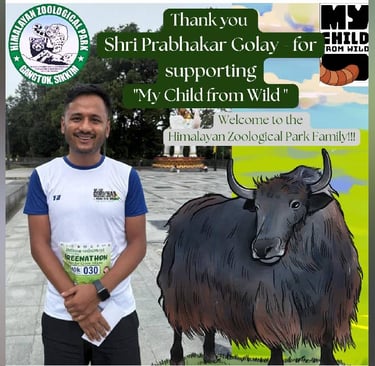Sikkim’s Prabhakar Golay embraces wildlife, adopts elder Yak ‘Abo’
Yaks across the Himalayas are known by different names—Rheeno in Sikkim, Pheno in Tibet. While Tibetan yaks graze the cold deserts, Sikkim’s Lhono are found in the dense alpine forests.
LOCAL


Prabhakar Golay, the Chief Patron of Garib Jan Kalyan Prakosta (GJKP), an NGO working across Sikkim, has now added a special member to his extended family; a senior yak at the Himalayan Zoological Park, whom he has lovingly adopted and named “Abo.”
Abo, meaning "elder" in many Himalayan dialects, is not just a yak. At ₹50,000, the adoption is symbolic of something much deeper—the quiet empathy of a man who has spent years serving others not for name or fame, but out of true concern for the sick, the poor, and the forgotten.
Through GJKP, Shri Golay has led a team of doctors, nurses, and social workers to offer free medical aid, spread awareness about citizen rights, and encourage young people to stand on their own feet. His work speaks louder than his words. Known for being thoughtful and soft-spoken, Prabhakar listens more than he speaks—a rare trait that has allowed him to truly understand people from remote corners of Sikkim.
“I look up to my father for his work, and my mother for her endless support,” he once shared during a small gathering. His days are grounded in routine: moments of solitude that help him recharge, and early morning runs and football matches that keep him fit.
His recent act of adopting a yak is more than just a gesture of goodwill. It reflects his deeper understanding and respect for Sikkim’s natural and cultural heritage. Yaks, known locally as Lhono in Sikkim, are an essential part of the Himalayan ecosystem and lifestyle. Male yaks are referred to as Yak, and females as Knoh. These animals, sensitive to their environment, rely on clean water and fresh alpine grass to survive.
Yaks across the Himalayas are known by different names—Rheeno in Sikkim, Pheno in Tibet. While Tibetan yaks graze the cold deserts, Sikkim’s Lhono are found in the dense alpine forests. Calving occurs between March and April, and this season brings with it a vibrant burst of life in the highlands—milk, cheese, butter, wool—all flow in abundance until September.
Interestingly, the long hair hanging from a yak’s back, called Tcheepoh, is traditionally used to make tents and curtains for nomadic communities. The fine baby hair shed by 2-year-old calves, known as Khulu, is highly valued—often compared to fine pashmina.
